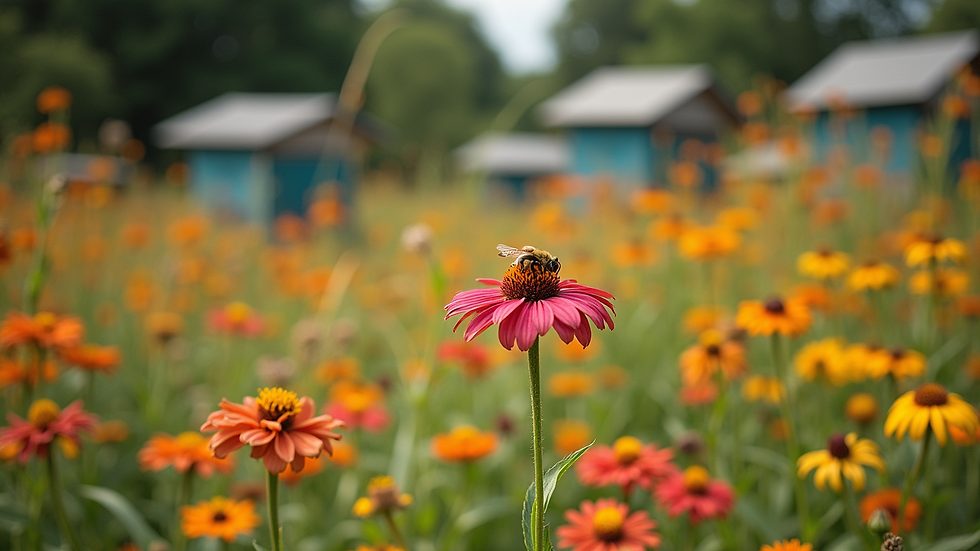How to Ensure Sustainable Honey Production
- The Wright Honey team
- Aug 18
- 3 min read
Honey is more than just a sweet treat. It connects us to nature and supports vital pollinators. I want to share how to keep honey production healthy and lasting. This helps bees, the environment, and those who enjoy honey. Let’s explore practical ways to support sustainable honey practices.
Why Sustainable Honey Practices Matter
Bees play a key role in our ecosystem. They pollinate plants that feed us and many animals. When we care for bees properly, we protect this natural cycle. Sustainable honey practices mean managing hives in ways that do not harm bees or their environment.
For example, avoiding harmful chemicals keeps bees safe. Using natural methods to control pests helps maintain hive health. Also, leaving enough honey for bees to eat ensures they survive winter. These steps keep bee colonies strong and productive.
Sustainable honey practices also support local ecosystems. Bees pollinate wildflowers and crops nearby. This boosts biodiversity and food production. When we buy honey from local beekeepers who follow these practices, we help the whole community.

Key Steps for Sustainable Honey Practices
I follow several simple steps to keep my hives healthy and productive. These steps help me practice sustainable honey production and protect the bees.
Choose the Right Location
Place hives where bees find plenty of flowers. Avoid areas with heavy pesticide use. A diverse range of plants nearby gives bees a balanced diet.
Use Natural Pest Control
Instead of chemicals, I use methods like screened bottom boards and natural predators. This keeps pests like varroa mites in check without harming bees.
Harvest Honey Responsibly
I only take surplus honey. Bees need enough to feed themselves through winter. Taking too much stresses the colony and can cause collapse.
Provide Clean Water
Bees need water for cooling the hive and making honey. I place shallow water dishes near hives with stones for landing.
Rotate Frames and Equipment
Old frames can harbor disease. I replace them regularly to keep the hive clean and healthy.
Monitor Hive Health Often
Regular checks help catch problems early. I look for signs of disease, pests, or queen issues.
Educate Yourself and Others
Learning about bees and sharing knowledge helps grow sustainable honey practices in the community.
These steps are easy to follow and make a big difference. They help me keep my bees thriving and producing quality honey.

What is the 7 10 Rule in Beekeeping?
The 7 10 rule is a simple guideline to protect bees during honey harvesting. It means leaving at least 7 to 10 kilograms of honey in the hive. This amount ensures bees have enough food to survive winter.
Many new beekeepers make the mistake of taking too much honey. This weakens the colony and can lead to starvation. By following the 7 10 rule, I help my bees stay strong and healthy.
This rule also supports sustainable honey production. It balances honey harvesting with bee welfare. It is a practical way to respect the needs of the hive while enjoying the fruits of their work.
Supporting Bees Through Habitat and Planting
Bees need more than just hives. They need good habitat and food sources. Planting bee-friendly flowers and trees helps provide this.
I plant native wildflowers, herbs, and shrubs around my hives. These plants bloom at different times, giving bees food all season. Avoiding lawns and bare soil also helps bees find pollen and nectar.
If you have space, consider creating a small pollinator garden. Use plants like clover, lavender, and sunflowers. These attract bees and other pollinators.
Supporting local green spaces and avoiding pesticides in your garden also helps. Every little bit adds up to a healthier environment for bees.

How to Choose and Support Sustainable Honey
When buying honey, look for products from beekeepers who follow sustainable honey practices. These producers care for their bees and the environment.
Check for local honey brands that share their beekeeping methods. Ask if they use natural pest control and follow the 7 10 rule. Buying local honey reduces transport emissions and supports your community.
You can also support sustainable honey production by learning beekeeping yourself. Many local groups offer workshops and supplies. Hawksview Honey, for example, provides education and quality products for hobbyists.
By choosing sustainable honey, you help protect bees and enjoy better quality honey. It’s a win-win for everyone.
Keeping the Buzz Alive
Sustainable honey practices are simple but powerful. They protect bees, support ecosystems, and provide delicious honey. By following these steps, I help keep my bees healthy and happy.
Whether you keep bees or just love honey, you can make a difference. Support local beekeepers who care for their hives. Plant bee-friendly flowers. Learn and share knowledge about bees.
Together, we can ensure honey production stays sustainable for years to come. For more tips and quality honey products, visit Hawksview Honey.
Let’s keep the buzz alive and enjoy the sweet rewards of nature.




Comments